Happy holidays from all of us at adaptED!
If you were surprised by how easily you reconnected with old friends or family over the holidays, don’t be! And don’t be surprised when we tell you that simple bonds and states of social comfort like those often experienced around holiday gatherings are really important for the classroom as well!
Our brains are wired to be social. The circuits that are dedicated to our understanding of each other’s thoughts, feelings and actions, the roots of our empathy connection, are known in neuroscience as mirror neurons. When we observe others moving, our brain responds as if we were moving ourselves. When we see each other cry, we feel their pain, and of course, we experience each other’s joy.

When there is connection in a classroom, between the teacher and the students as well as among the students themselves, learners will be invested in successful progress through the content not only for themselves, but also for their peers. And mirror neuron circuits are most active in collaborative and connected environments. In other words, when a student reaches an academic milestone or conquers a challenge that leads to taking another step in the lesson, their peers, experiencing one another’s joy, are just as rewarded as the student themselves.
Students who feel emotionally connected in their learning environment will be more engaged and experience long-term payoffs both academically and socially. And don’t be surprised if you find a happier and healthier teacher who feels even more invested in their students.
Simple activities we suggest:
Enhancing mirror neuron networks through community-building can be done in a variety of simple ways and can be combined with academic content.
Make a wishing wall or a gratitude tree. (Click here to download one from us) Have your students make leaves out of green paper and write daily what they are grateful for and attach to the tree. You can specify to be within the confines of the classroom social environment. As the tree fills with leaves your students will feel more connected and grateful
Build in personal sharing time: Spending circle time talking about themselves, what their fears are, what they do at home, where they are from. For younger kids: Bring a book and stuffed animal from home on the first day to share (talking), or just show (no talking), at circle time.
Do simple team building activities: The human knot is a great one and requires no materials and only a few minutes to complete and this book is full of easy activities that are often appropriate for kids.
Getting to know each other and your students with this handy print-out from us. (Best for 2nd grade and up) Note: Also good for staff getting to know you events!
Create self-portraits that include one favorite thing or person, then share in small groups.
Build a Forest: Stand on one foot in a circle. Instruct students to put their hands out palm to palm so that the circle is completed. Once students are settled the teacher begins a gentle sway that finds its way around the circle one person at a time until it returns to the teacher. Try variations on this depending on age and ability. Discussion question: Which way is easier, one tree alone in the wind or a whole forest full of trees working together?
Many small twigs are strong when bundled : Have students bring a few twigs from home. At circle time easily break one. Then collect all of the twigs and try to break them once they are bundled (you can’t). Have students discuss these implications for using each other as sources of support and strength. Tie together with a few ribbons or rubberbands and refer to/discuss as needed during the school year.

3 thoughts on “The Neurons that Bind Us: Why Mirror Neurons Matter For Your Classroom”
Comments are closed.